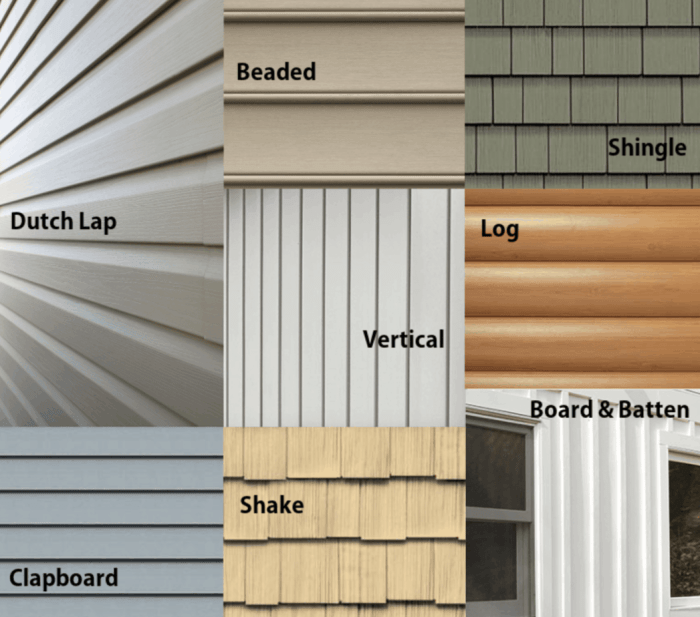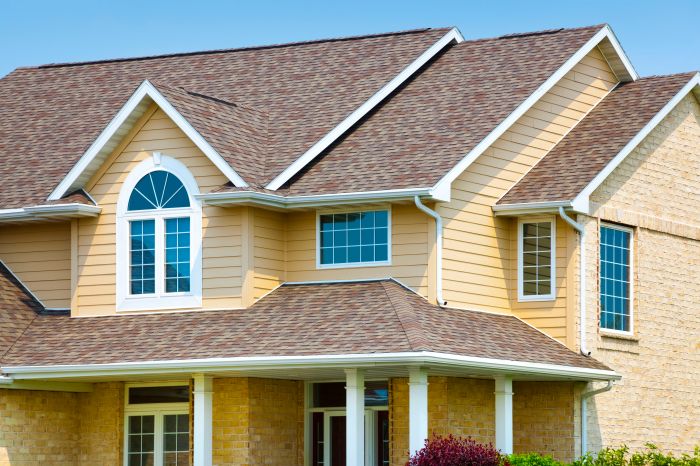Exploring Different House Siding Types
Diving into the realm of house siding types, this introduction offers a captivating glimpse into the world of siding materials. From the classic appeal of wood to the modern allure of metal, the choices are vast and intriguing.
As we navigate through the intricacies of each siding type, we uncover the unique characteristics, benefits, and considerations that come into play when selecting the perfect siding for your home.
Introduction to House Siding Types
House siding is the exterior material applied to the walls of a house to protect it from the elements and enhance its curb appeal. Choosing the right siding material is crucial as it not only affects the aesthetics of the home but also plays a significant role in insulation and protection against weather conditions.
There are various types of house siding available, each with its own unique characteristics and benefits.
Vinyl Siding
Vinyl siding is one of the most popular choices for homeowners due to its affordability, low maintenance, and durability. It comes in a wide range of colors and styles, making it a versatile option for different architectural designs.
Fiber Cement Siding
Fiber cement siding is a durable and long-lasting option that mimics the look of wood or stucco without the maintenance issues. It is resistant to rot, fire, and insects, making it a practical choice for many homeowners.
Wood Siding
Wood siding offers a classic and natural look to a home, adding warmth and charm. While it requires more maintenance compared to other materials, many homeowners appreciate the unique character and beauty that wood siding brings.
Aluminum Siding
Aluminum siding is lightweight, easy to install, and resistant to corrosion, making it a practical choice for coastal areas or regions with high humidity. It is available in various colors and can be painted to suit different preferences.
Brick Siding
Brick siding is known for its durability, energy efficiency, and timeless appeal. While it is a more expensive option, many homeowners appreciate the low maintenance and longevity that brick siding offers.
Vinyl Siding
Vinyl siding is a popular choice for homeowners due to its durability, versatility, and low maintenance requirements. It is made from polyvinyl chloride (PVC) resin, making it resistant to rot, insect damage, and weathering.
Characteristics of Vinyl Siding:
- Available in a wide range of colors and textures to suit various architectural styles.
- Easy to install and lightweight, reducing labor costs.
- Requires minimal maintenance, only needing occasional cleaning with soap and water.
- Resistant to fading, cracking, and warping over time.
Benefits of Using Vinyl Siding:
- Cost-effective compared to other siding materials like wood or brick.
- Energy-efficient options available with added insulation to improve home's thermal performance.
- Durable and long-lasting, providing a protective barrier for your home for years to come.
- Low maintenance requirements save time and money on upkeep.
Cost Comparison of Vinyl Siding:
- On average, vinyl siding costs less upfront compared to materials like wood or fiber cement.
- Installation costs are lower due to the ease and speed of installation.
- Long-term savings on maintenance and repairs make vinyl siding a cost-effective choice for homeowners.
Wood Siding

Wood siding is a popular choice among homeowners due to its traditional and timeless appeal. The natural beauty and warmth of wood can enhance the overall aesthetic of a house, giving it a classic look that never goes out of style.
Maintenance Requirements
Wood siding requires regular maintenance to ensure its longevity and beauty. This includes painting or staining every few years to protect the wood from moisture, rot, and pests. Additionally, it's important to inspect the siding for any signs of damage and address them promptly to prevent further issues.
Environmental Impact
Using wood siding can have both positive and negative environmental impacts. On one hand, wood is a renewable resource that can be sustainably harvested
Fiber Cement Siding

Fiber cement siding is a popular choice for homeowners looking for a durable and low-maintenance option for their homes. Made from a mixture of cement, sand, and cellulose fibers, this type of siding is known for its strength and resistance to elements like moisture, fire, and pests.One of the key features that make fiber cement siding stand out is its longevity.
It can last for decades with minimal maintenance, making it a cost-effective option in the long run. Additionally, fiber cement siding comes in a variety of colors and styles, allowing homeowners to achieve the look they desire for their homes.
Homes Where Fiber Cement Siding is Commonly Used
- Suburban homes: Fiber cement siding is a popular choice for suburban homes due to its durability and resistance to weather conditions.
- Coastal homes: Given its resistance to moisture and salt air, fiber cement siding is often used in coastal areas where homes are exposed to harsh weather elements.
- Craftsman-style homes: The versatility of fiber cement siding allows it to be used in a variety of architectural styles, including Craftsman homes that require a classic and timeless look.
Metal Siding
Metal siding is a popular choice for homeowners looking for a durable and modern exterior cladding option. It offers a sleek and contemporary look that can enhance the overall aesthetics of a home.
Types of Metal Siding
Metal siding comes in various types, including aluminum, steel, and zinc. Each type has its unique characteristics and benefits. Aluminum siding is lightweight and resistant to corrosion, making it a popular choice. Steel siding is known for its strength and durability, while zinc siding offers a distinct weathered look that can add character to a home.
Longevity and Durability
Metal siding is highly durable and can last for several decades with proper maintenance. It is resistant to rot, pests, and fire, making it a long-term investment for homeowners. Additionally, metal siding requires minimal upkeep compared to other siding materials, saving time and money in the long run.
Aesthetic Appeal
Metal siding is favored for its modern and sleek appearance, making it a popular choice for contemporary homes. It can be customized in various colors and finishes to complement different architectural styles. The clean lines and smooth surface of metal siding give a sophisticated look to any home, adding to its curb appeal.
Brick Siding
Brick siding is a popular choice for homeowners due to its durability and timeless aesthetic appeal. In addition to its classic look, brick siding offers several benefits in terms of insulation, cost implications, and architectural styles that complement its appearance.
Insulation Benefits
One of the main advantages of brick siding is its excellent insulation properties. Bricks have a high thermal mass, which means they can absorb and store heat, helping to regulate indoor temperatures and reduce energy costs. The air pockets within the brick also provide additional insulation, keeping homes warm in winter and cool in summer.
Cost Implications
While brick siding may have a higher upfront cost compared to other siding materials, such as vinyl or wood, it is a long-term investment that can save money on energy bills over time. Additionally, brick siding is low maintenance and durable, reducing the need for frequent repairs or replacements, further adding to its cost-effectiveness.
Architectural Styles
Brick siding is versatile and can complement a variety of architectural styles, from traditional to modern. Examples of architectural styles that work well with brick siding include Colonial, Tudor, and Craftsman homes. The timeless appeal of brick can enhance the curb appeal of any home and add a sense of sophistication and elegance to the overall design.
Summary
In conclusion, the diverse array of house siding types opens up a world of possibilities for homeowners seeking to enhance the aesthetics and functionality of their abode. By understanding the nuances of each material, you can make an informed decision that suits your style and budget.
Common Queries
What is the most cost-effective house siding type?
Vinyl siding is typically considered the most cost-effective option due to its affordability and low maintenance requirements.
Is wood siding environmentally friendly?
While wood siding is a natural material, its environmental impact can vary depending on the sourcing and processing of the wood. Look for sustainably sourced wood to minimize environmental impact.
Which house siding type offers the best insulation?
Brick siding is known for its excellent insulation properties, helping to regulate indoor temperatures and reduce energy costs.




